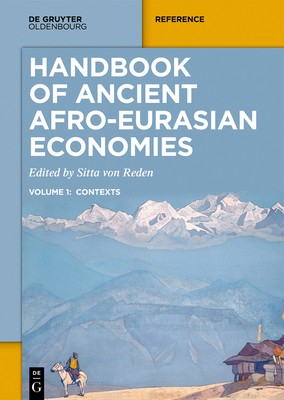
- We will send in 10–14 business days.
- Publisher: Walter de Gruyter
- Year: 2019
- Pages: 600
- ISBN-10: 3110604515
- ISBN-13: 9783110604511
- Format: 17.8 x 24.4 x 4.6 cm, hardcover
- Language: English
- SAVE -10% with code: EXTRA
Handbook of Ancient Afro-Eurasian Economies (e-book) (used book) | bookbook.eu
Reviews
Description
The notion of the "Silk Road" that the German geographer Ferdinand von Richthofen invented in the 19th century has lost attraction to scholars in light of large amounts of new evidence and new approaches. The handbook suggests new conceptual and methodological tools for researching ancient economic exchange in a global perspective with a strong focus on recent debates on the nature of pre-modern empires.
The interdisciplinary team of Chinese, Indian and Graeco-Roman historians, archaeologists and anthropologists that has written this handbook compares different forms of economic development in agrarian and steppe regions in a period of accelerated empire formation during 300 BCE and 300 CE. It investigates inter-imperial zones and networks of exchange which were crucial for ancient Eurasian connections.
Volume I provides a comparative history of the most important empires forming in Northern Africa, Europe and Asia between 300 BCE and 300 CE. It surveys a wide range of evidence that can be brought to bear on economic development in the these empires, and takes stock of the ways academic traditions have shaped different understandings of economic and imperial development as well as Silk-Road exchange in Russia, China, India and Western Graeco-Roman history.
EXTRA 10 % discount with code: EXTRA
The promotion ends in 11d.19:03:37
The discount code is valid when purchasing from 10 €. Discounts do not stack.
- Publisher: Walter de Gruyter
- Year: 2019
- Pages: 600
- ISBN-10: 3110604515
- ISBN-13: 9783110604511
- Format: 17.8 x 24.4 x 4.6 cm, hardcover
- Language: English English
The notion of the "Silk Road" that the German geographer Ferdinand von Richthofen invented in the 19th century has lost attraction to scholars in light of large amounts of new evidence and new approaches. The handbook suggests new conceptual and methodological tools for researching ancient economic exchange in a global perspective with a strong focus on recent debates on the nature of pre-modern empires.
The interdisciplinary team of Chinese, Indian and Graeco-Roman historians, archaeologists and anthropologists that has written this handbook compares different forms of economic development in agrarian and steppe regions in a period of accelerated empire formation during 300 BCE and 300 CE. It investigates inter-imperial zones and networks of exchange which were crucial for ancient Eurasian connections.
Volume I provides a comparative history of the most important empires forming in Northern Africa, Europe and Asia between 300 BCE and 300 CE. It surveys a wide range of evidence that can be brought to bear on economic development in the these empires, and takes stock of the ways academic traditions have shaped different understandings of economic and imperial development as well as Silk-Road exchange in Russia, China, India and Western Graeco-Roman history.


Reviews